Click on images to enlarge
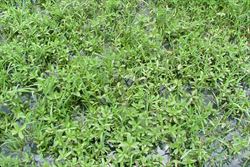
infestation in shallow water (Photo: Sheldon Navie)
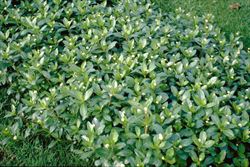
terrestrial infestation (Photo: Trevor James)
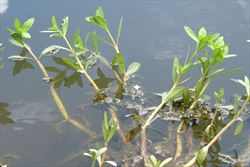
habit growing in water (Photo: Sheldon Navie)
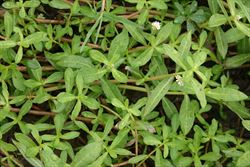
habit on land (Photo: Trevor James)

aquatic stems and leaves (Photo: Sheldon Navie)

close-up of hollow stem (Photo: Trevor James)

lower stem with roots developing at its joints (Photo: Sheldon Navie)

upper stem with paired leaves (Photo: Sheldon Navie)
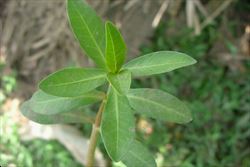
close-up of leaves (Photo: Sheldon Navie)
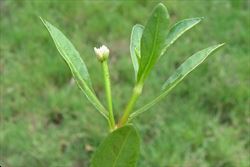
young flower cluster borne on a long stalk (Photo: Sheldon Navie)
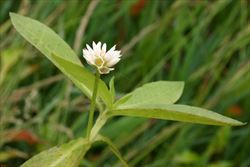
close-up of flowers (Photo: Trevor James)
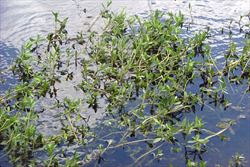
infestation in deeper water in Stable Swamp Creek (Photo: Sheldon Navie)

close-up of leaf underside (Photo: Trevor James)
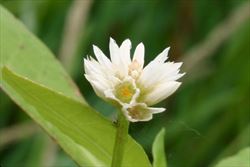
close-up of white flowers (Photo: Trevor James)

close-up of mature fruit, which is mostly hidden by the old flower parts (Photo: Julia Scher)
Scientific Name
Alternanthera philoxeroides (Mart.) Griseb.
Synonyms
Achyranthes philoxeroides (Mart.) StandleyBucholzia philoxeroides Mart.Telanthera philoxeroides (Mart.) Moq.
Family
Amaranthaceae
Common Names
alligator grass, alligator weed, alligatorweed, mukuna-menna, pannankarni, pig weed
Origin
Native to South America (i.e. French Guiana, Guyana, Surinam, Venezuela, Brazil, Bolivia, Peru, Paraguay, Uruguay and northern Argentina).
Cultivation
Though this species is believed to have been accidentally introduced into Australia in the ballast of ships arriving at the Newcastle docks in the 1940's, it is sometimes cultivated as a culinary plant. In particular, it has been grown as a garden vegetable by the Sri Lankan community in major Australian cities.
Naturalised Distribution
Though this species is quite widespread, it is not yet very common in Australia. It is mainly found in the coastal regions of central New South Wales (i.e. near Sydney) and in southern Victoria (i.e. near Melbourne). It is present in other parts of New South Wales and Victoria and has occasionally been recorded in the ACT and eastern Queensland.
Also widely naturalised in other parts of the world including in the USA, the Caribbean, southern Europe (i.e. France and Italy), tropical Asia (e.g. India, Sri Lanka, China, Taiwan, Indonesia, Myanmar, Singapore, Thailand and Papua New Guinea) and New Zealand.
Habitat
This species has become a weed in the warmer temperate, sub-tropical and tropical regions of Australia. It usually grows in aquatic habitats (e.g. canals, rivers, swamps, lakes, dams, ditches, etc.), being rooted to the ground and emerging above the water surface. However, it can also be found free-floating in dense mats on the water surface or growing in terrestrial habitats. It is also a potential weed of wetter pastures and irrigated crops (e.g. rice) in Australia.
Habit
A long-lived (i.e. perennial) aquatic, semi-aquatic or terrestrial herbaceous plant with a creeping (i.e. prostrate), semi-upright (i.e. ascending) or free-floating growth habit.
Distinguishing Features
- a semi-aquatic, aquatic, or terrestrial herbaceous plant that produces roots at its stem joints.
- these stems are often hollow when growing in water, and form dense mats of vegetation out over the water surface.
- its oppositely arranged leaves are almost stalkless and elongated in shape (2-14 cm long and 1-4 cm wide).
- its flowers are borne in dense globular clusters (1-2 cm across) on stalks 2-9 cm long in the forks of the upper leaves.
- these small flowers have five white 'petals' that acquire a papery appearance as the fruit mature.
Stems and Leaves
The stems of this weed often grow as runners along the ground (i.e. stolons) or creeping below the ground surface (i.e. rhizomes). They may also spread out over the surface of water bodies and tend to form dense mats of vegetation (up to 1 m thick). These aquatic stems usually become hollow as they mature, which aids in floatation. The production of roots (i.e. adventitious roots) from the joints (i.e. nodes) of these stems is quite common. Stems can be up to 10 m long and mats of vegetation can be formed up to 15 m out over the water surface. Younger stems are light green to reddish in colour, hairless (i.e glabrous), and have slightly swollen joints (i.e. nodes).
The dark green leaves are borne in pairs along the stems and usually do not have any leaf stalks (i.e. they are sessile or sub-sessile). They are elongated in shape (i.e. narrowly elliptic to lanceolate) with entire margins and pointed tips (i.e. acute apices). These leaves (2-14 cm long and 1-4 cm wide) are also hairless (i.e. glabrous) and have a somewhat waxy appearance.
Flowers and Fruit
The whitish flowers are borne in dense globular clusters (1-2 cm across) at the top of stalks (i.e. peduncles) 2-9 cm long. These flower clusters are usually produced in the forks (i.e. axils) of the upper leaves. Each flower has five small white 'petals' (i.e. perianth segments or tepals) and five yellow stamens. The 'petals' (5-7 mm long) tend to develop a papery appearance and may turn straw-coloured as they mature. Flowering occurs from late spring through to early autumn.
The small fruiting 'capsules' (i.e. utricles) are brownish in colour, bladder-like in appearance, and contain a single seed. These seeds are smooth in texture and oval (i.e. elliptic) in shape, but are rarely produced in Australia.
Reproduction and Dispersal
This plant can reproduce by seed and vegetatively by stem fragments. However, because seeds are generally not produced in Australia, most reproduction here is vegetative.
Stem segments, which have the ability to float, are easily dispersed by floods and water currents. They may also be spread by boats and other water craft, in dumped garden waste, and by animals or vehicles.
Environmental Impact
Alligator weed (Alternanthera philoxeroides) is already an important environmental weed in New South Wales, Victoria and Queensland, and is seen as a potentially significant environmental weed in many other parts of Australia. It is regarded as one of the worst weeds in Australia because of its invasiveness, potential for spread, and economic and environmental impacts. In fact, this species has been named as one of Australia's 20 Weeds of National Significance (WoNS). It is thought that the potential range of alligator weed (Alternanthera philoxeroides) includes waterways throughout most of southern and eastern Australia.
It is an especially troublesome weed because it invades both terrestrial and aquatic habitats, and is very difficult to eradicate. Alligator weed (Alternanthera philoxeroides) can totally disrupt natural aquatic ecosystems by blanketing the surface of the water with thick mats of vegetation that impede the penetration of light below the water surface, shading out any submerged native plant species. These mats also promote sedimentation and flooding and prevent gaseous exchange, leading to a reduction in water quality (i.e. reduced oxygen levels in the water). Such changes to aquatic ecosystems can have significant negative impacts on the native plants and animals growing in them (e.g. reduce water bird and fish activity, cause the death of native fish and replace native wetland plants). When growing on land it also grows into a dense mat of vegetation with a mass of creeping underground stems (i.e. rhizomes) and is capable of out-competing all but the most robust plant species. It quickly displaces native plants and can be harmful to the native animals that rely on them.
Alligator weed (Alternanthera philoxeroides) is currently having the greatest impact in New South Wales, where the total infested area is now estimated at 3,950 hectares. It has spread from initial sites in the Newcastle area to invade aquatic habitats and seasonally flooded land in the Fullerton Cove, Williamtown and Raymond Terrace areas in the Lower Hunter region. In the Sydney region, alligator weed (Alternanthera philoxeroides) has spread throughout the Parramatta and Georges River catchments. It has also spread to many other locations in the Sydney basin including the Botany wetlands, several northern suburbs and the Hurstville area. However, its continual spread downstream in the Hawkesbury/Nepean catchment, which now has approximately 70 km of infested waterways, in of most concern in this region. Large infestations have also bee located in Barren Box Swamp, near Griffith, and in a tributary of the Richmond River, on the far north coast.
It should also be noted that alteration to the natural flow regimes of rivers, streams, floodplains and wetlands has been listed as a "key threatening process" to natural ecosystems in New South Wales. Exotic plant species such as alligator weed (Alternanthera philoxeroides) have reduced stream flows and substantially contributed to this worsening environmental problem (i.e. by impeding water flow and increasing water loss through transpiration).
Alligator weed (Alternanthera philoxeroides) has also been found at several hundred sites in Victoria, though most of these sites are in backyards in suburban Melbourne. It is listed among the top 50 most invasive plant species in south-eastern Queensland, even though it is not yet widely naturalised in this region. This species is also regarded as a potentially invasive garden plant in the Greater Adelaide region and is considered to to pose a significant threat to Adelaide's biodiversity.
Alligator weed (Alternanthera philoxeroides) is also very invasive overseas, and is considered to be one of the worst aquatic weeds in the world. In the USA, it forms dense tangled mats of vegetation that overtop native aquatic plants and out-compete them for sunlight. It eventually replaces desirable native species and can significantly alter the aquatic and riverine ecology of heavily infested areas. This species also invades drains, streams, swamps and similar wet habitats in New Zealand and is noted to be harmful to native biodiversity in China. It is also a major problem parts of southern Asia (i.e. in Burma, Thailand, Indonesia and India).
Other Impacts
In Australia, Alligator weed (Alternanthera philoxeroides) has the potential to invade important agricultural systems and significantly reduce productivity in these regions. Control of this species has also proven to be an expensive and complicated ordeal wherever it has become well established. It is seen as a major threat to irrigated crops, particularly rice crops in the south-western region of New South Wales. During one study, is was estimated that the costs to agriculture in New South Wales could be as high as $250 million per annum if alligator weed (Alternanthera philoxeroides) was to reach its potential distribution in this state.
Alligator weed (Alternanthera philoxeroides) can increase flood damage by impeding the flow of waterways, promoting sedimentation and blocking drainage channels. It can also prevent access to and use of water by livestock and humans, damage pumping and irrigation equipment, disrupt various recreational activities (e.g. recreational water sports, boating, fishing and swimming), degrade the natural aesthetics of invaded areas, and promote health problems by providing habitat for disease-carrying mosquitoes.
Legislation
This species is declared under legislation in the following states and territories:
- ACT: C1 - a notifiable pest plant, (a pest plant whose presence must be notified), and C4 - a prohibited pest plant (a pest plant whose propagation and supply is prohibited).
- New South Wales: Class 2 - a regionally prohibited weed. The presence of the weed must be notified to the local control authority and it must be eradicated from the land and the land must be kept free of the plant (in a large number of local authority areas), Class 3 - a regionally controlled weed. The relevant local control authority must be promptly notified of the presence of this weed and it must be fully and continuously suppressed and destroyed (in a large number of local authority areas). See the New South Wales Department of Primary Industries Noxious Weeds List at http://www.dpi.nsw.gov.au for more detailed information on which local areas are covered in these declarations.
- Northern Territory: A - to be eradicated (throughout all of the Territory), and C - not to be introduced into the Territory.
- Queensland: Class 1 - introduction into the state is prohibited, and landowners must take reasonable steps to keep land free of this species (throughout the entire state). It is also illegal to sell a declared plant or its seed in this state.
- South Australia: 1@ - this species is declared in Class 1a, and is regarded as a prohibited aquatic weed. Its presence must be notified and the plant must be destroyed (throughout the entire state).
- Tasmania: D - the importation or sale of this species is prohibited and measures to reduce its population in an area, eradicate it from an area, or restrict it to a particular area may be required.
- Victoria: S - prohibited and is to be eradicated from the state if possible.
- Western Australia: P1 - trade, sale or movement into the state prevented, and P2 - to be eradicated (throughout the entire state).
Management
For information on the management of this species see the following resources:
- the National Weeds Strategy Strategic Plan for this species, which is available online at http://www.weeds.org.au/docs/alistrat.pdf.
- the Biosecurity Queensland Fact Sheet on this species, which is available online at http://www.dpi.qld.gov.au.
- the New South Wales Department of Primary Industries Agfact on this species, which is available online at http://www.dpi.nsw.gov.au.
- the Victorian Department of Natural Resources and Environment Landcare Note on this species, which is available online at http://www.dpi.vic.gov.au.
- the Northern Territory Department of Natural Resources, Environment and The Arts Agnote on this species, which is available online at http://www.nt.gov.au/weeds.
Similar Species
Alligator weed (Alternanthera philoxeroides) is similar to several native and introduced species of joyweeds (Alternanthera spp.), including lesser joyweed (Alternanthera denticulata), hairy joyweed (Alternanthera nana), calico plant (Alternanthera ficoidea), purple joyweed (Alternanthera brasiliana), khaki weed (Alternanthera pungens) and gomphrena weed (Gomphrena celosioides). However, it is the only one of these species that has hollow floating stems or forms dense mats over the water surface.
The native joyweeds (e.g. Alternanthera denticulata and Alternanthera nana) can also be easily distinguished from terrestrial alligator weed (Alternanthera philoxeroides) plants by the fact that their whitish flower clusters are stalkless. The other species can be separated by the following differences:
- alligator weed (Alternanthera philoxeroides) is a large and robust plant with relatively large green leaves (2-14 cm long) that are almost hairless (i.e. glabrous). Its flowers are borne in relatively large, rounded, clusters (1-2 cm across) at the end of a flower stalk (i.e. peduncle) 2-9 cm long that grows from the upper leaf forks (i.e. axils).
- calico plant (Alternanthera ficoidea) is a relatively small plant with relatively small leaves (1-6 cm long) that are somewhat hairy (i.e. pubescent). Its flowers are borne in moderately large, dense, stalkless (i.e. sessile), clusters (5-12 mm across) in the upper leaf forks (i.e. axils).
- purple joyweed (Alternanthera brasiliana) is a large and robust plant with relatively large purplish coloured leaves (about 10-15 cm long) that are almost hairless (i.e. glabrous). Its flowers are borne in relatively large, dense, clusters (10-20 mm across) at the end of a flower stalk (i.e. peduncle) 2-10 cm long that grows from the upper leaf forks (i.e. axils).
- khaki weed (Alternanthera pungens) is a small creeping plant with relatively small leaves (0.5-5 cm long) that are almost hairless (i.e. glabrous). Its flowers are borne in relatively small, dense, stalkless (i.e. sessile), clusters (8-12 mm across) in the upper leaf forks (i.e. axils) and produce spiny fruit.
- gomphrena weed (Gomphrena celosioides) is a small plant with relatively small leaves (2-5 cm long) that are somewhat hairy (i.e. pubescent). Its flowers are borne in relatively large, dense, stalkless (i.e. sessile), clusters (up to 4 cm long) at the tips of its stems.
The water primroses (Ludwigia adscendens and Ludwigia peploides subsp. montevidensis) often form similar dense mats of vegetation out over the water surface. However, these species can be distinguished by their alternately arranged leaves, larger four-petalled flowers (about 25 mm across) and elongated fruit.

